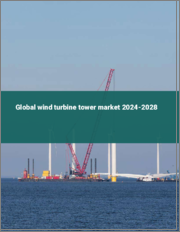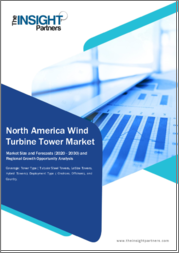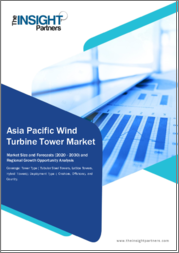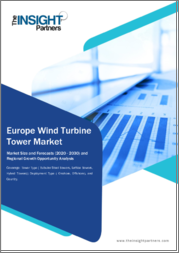
|
시장보고서
상품코드
1717765
풍력 터빈 타워 시장 : 유형별, 소재 유형별, 타워 높이별, 설치 장소별, 용도 유형별, 최종 이용 산업별 - 세계 예측(2025-2030년)Wind Turbine Tower Market by Type, Material Type, Tower Height, Installation, Application Type, End User Industry - Global Forecast 2025-2030 |
||||||
풍력 터빈 타워 시장은 2024년에는 249억 2,000만 달러로 평가되었으며, 2025년에는 268억 2,000만 달러, CAGR 7.80%로 성장하여 2030년에는 391억 2,000만 달러에 달할 것으로 예측됩니다.
| 주요 시장 통계 | |
|---|---|
| 기준 연도 2024년 | 249억 2,000만 달러 |
| 추정 연도 2025년 | 268억 2,000만 달러 |
| 예측 연도 2030년 | 391억 2,000만 달러 |
| CAGR(%) | 7.80% |
풍력 터빈 타워 시장은 재생에너지의 주요 부문으로 빠르게 발전하고 있습니다. 기술 발전과 지속가능한 에너지 솔루션에 대한 관심이 높아짐에 따라 이 분야는 시야를 넓혀가고 있습니다. 최근 몇 년 동안 청정에너지 인프라에 대한 투자 증가와 전 세계의 이산화탄소 배출량 감축 추진으로 인해 타워 설계 및 건설에 대한 연구와 기술 혁신이 가속화되고 있습니다. 기업과 정부 모두 기존 화석 연료에 대한 의존도를 낮추기 위해 효율적이고 내구성이 뛰어나며 비용 효율적인 풍력 터빈 타워의 중요성이 가장 중요해지고 있습니다.
최신 풍력 터빈 타워는 높은 기술력을 보여줄 뿐만 아니라 풍력에너지를 효과적으로 활용하기 위해 필수적인 요소이기도 합니다. 신뢰성, 안전성, 성능에 대한 명확한 초점이 맞춰지면서 업계 이해관계자들은 현재 구조적 안정성과 적응성을 강화한 솔루션을 우선시하고 있습니다. 이러한 변화는 재료, 설계 형태, 설치 기술, 유지보수 방법에 대한 지속적인 연구로 뒷받침되고 있습니다. 복잡한 시장 역학에서 살아남기 위해서는 재생에너지 분야를 재편하고 있는 근본적인 트렌드와 주요 촉진요인을 이해하는 것이 필수적입니다.
이 주요 요약에서는 풍력 터빈 타워 시장의 다양한 측면에 대해 자세히 설명합니다. 풍력 터빈 타워의 변천사를 살펴보고, 세분화에 대한 자세한 인사이트를 제공하며, 지역 및 기업별 분석을 제시합니다. 각 섹션은 이 역동적인 시장의 미래 성장 궤도를 이해하고자 하는 베테랑 전문가와 의사결정자 모두에게 명확성을 제공하기 위해 만들어졌습니다.
풍력 터빈 타워 시장의 변화
기술 혁신과 진화하는 시장 역학은 풍력 터빈 타워 산업을 재정의하고 있습니다. 최근 추세는 성능을 향상시킬 뿐만 아니라 설치 절차를 간소화하는 보다 적응력 있는 설계 및 시공 기술로 전환하고 있습니다. 시장은 점차 전통적인 방식에서 점점 더 까다로워지는 환경의 도전에 대응할 수 있는 보다 진보된 엔지니어링 솔루션으로 이동하고 있습니다.
이러한 진화는 재료 효율성, 구조적 무결성, 비용 효율성에 초점을 맞춘 연구 개발의 급증으로 두드러지게 나타나고 있습니다. 기업들이 전통적인 엔지니어링의 한계를 뛰어넘으면서 표준화된 타워 설계에서 특정 환경과 운영 조건에 맞는 맞춤형 솔루션으로의 전환이 두드러지게 나타나고 있습니다. 이러한 변화는 디지털 모니터링 시스템과 예지보전 기법을 통합하여 잠재적인 운영상의 문제를 미리 예측하는 데 도움이 되는 디지털 모니터링 시스템의 통합으로 더욱 강조되고 있습니다.
또한, 다양한 지역에서의 규제 변경과 정부 인센티브는 이러한 변화에 더욱 박차를 가하고 있습니다. 지속가능성과 신뢰성에 대한 업계의 명확한 합의에 따라, 시장 참여자들은 경쟁력 있는 가격을 유지하면서 우수한 성능을 제공할 수 있는 차세대 기술에 투자하고 있습니다. 끊임없는 진화를 통해 다양한 지역에서 운영할 수 있는 더 크고 효율적인 터빈이 등장하고 있으며, 풍력에너지가 세계 에너지 전환의 핵심이 될 수 있는 기반을 마련하고 있습니다.
주요 부문 분석
풍력 터빈 타워 시장의 종합적인 세분화 분석은 시장의 성장 궤도에 중요한 역할을 하는 여러 고급 계층을 밝혀냈습니다. 유형에 따른 세분화는 원통형 타워, 하이브리드 타워, 테이퍼 타워와 같은 타워의 구분을 강조하며, 각 타워는 설계 및 성능 요구 사항에 따라 고유 한 이점을 제공합니다. 이와 함께 재료 유형에 따른 분석은 콘크리트, 하이브리드, 강철의 사용을 고려하여 내구성과 적응성의 조합이 각 설비의 환경 조건 및 구조적 요구 사항에 적합하도록 합니다.
또 다른 중요한 측면은 타워의 높이로, 100미터 이하의 구조물, 100미터에서 150미터 범위의 구조물, 150미터 이상의 타워에 따라 고려해야 할 성능이 달라집니다. 이 구분은 건설과 유지보수의 복잡성 사이의 균형을 유지하면서 에너지 포집량을 극대화하는 데 결정적인 역할을 합니다. 마찬가지로, 설치 세분화는 획일적인 접근 방식을 적용하는 것이 아니라 신규 프로젝트와 기존 타워의 개보수를 구분합니다.
용도 구분에서는 해양과 육상을 추가로 구분하고 있습니다. 해양에서는 고정식 구조물과 부유식 구조물이 고려되며, 부유식 구조물은 반잠수식 플랫폼과 장력다리식 플랫폼으로 분류됩니다. 한편, 육상 애플리케이션은 설치 장소의 풍속 조건에 따라 강풍, 중풍, 저풍 시나리오로 구분하여 신중하게 분류됩니다. 마지막으로, 최종사용자 산업을 기반으로 한 세분화에서는 산업, 주거 및 유틸리티 부문이 이러한 혁신적인 시스템의 주요 수혜자로 식별되며, 주거용 설치는 그리드 연결 및 오프그리드 전략에 따라 추가적으로 분석됩니다. 이러한 복잡한 시장 분석은 시장이 다양한 요구와 상황에 대응할 수 있음을 강조합니다.
목차
제1장 서문
제2장 조사 방법
제3장 주요 요약
제4장 시장 개요
제5장 시장 인사이트
- 시장 역학
- 성장 촉진요인
- 성장 억제요인
- 기회
- 해결해야 할 과제
- 시장 세분화 분석
- Porter’s Five Forces 분석
- PESTLE 분석
- 정치
- 경제
- 사회
- 기술
- 법률
- 환경
제6장 풍력 터빈 타워 시장 : 유형별
- 원통형 타워
- 하이브리드 타워
- 테이퍼드 타워
제7장 풍력 터빈 타워 시장 : 소재 유형별
- 콘크리트
- 하이브리드
- 강철
제8장 풍력 터빈 타워 시장 : 타워 높이별
- 100-150미터
- 150미터 이상
- 100미터 이하
제9장 풍력 터빈 타워 시장 : 설치별
- 신규
- 개조
제10장 풍력 터빈 타워 시장 : 용도 유형별
- 오프쇼어
- 고정 구조
- 유체 구조물
- 반잠수형
- 텐션 레그 플랫폼
- 온쇼어
- 고풍속 지점
- 저풍속 지점
- 중풍속 지점
제11장 풍력 터빈 타워 시장 : 최종 이용 업계별
- 산업
- 주거용
- 그리드 연결
- 오프그리드
- 유틸리티
제12장 아메리카의 풍력 터빈 타워 시장
- 아르헨티나
- 브라질
- 캐나다
- 멕시코
- 미국
제13장 아시아태평양의 풍력 터빈 타워 시장
- 호주
- 중국
- 인도
- 인도네시아
- 일본
- 말레이시아
- 필리핀
- 싱가포르
- 한국
- 대만
- 태국
- 베트남
제14장 유럽, 중동 및 아프리카의 풍력 터빈 타워 시장
- 덴마크
- 이집트
- 핀란드
- 프랑스
- 독일
- 이스라엘
- 이탈리아
- 네덜란드
- 나이지리아
- 노르웨이
- 폴란드
- 카타르
- 러시아
- 사우디아라비아
- 남아프리카공화국
- 스페인
- 스웨덴
- 스위스
- 튀르키예
- 아랍에미리트
- 영국
제15장 경쟁 구도
- 시장 점유율 분석, 2024
- FPNV 포지셔닝 매트릭스, 2024
- 경쟁 시나리오 분석
- 전략 분석과 제안
기업 리스트
- Aeolos Wind Energy Ltd
- Anyang Machinery Co., Ltd by CNBM Group
- Arcosa Wind Towers, Inc.
- Bergey Windpower Co.
- Broadwind Energy Inc.
- CS Wind Corporation
- Cubuilt Engineers Pvt Ltd.
- Dongkuk S&C
- Enel Green Power S.p.A.
- ENERCON Global GmbH
- Faccin Group
- General Electric Company
- GRI Renewable Industries
- Hitachi, Ltd.
- KGW Schweriner Maschinen-und Anlagenbau GmbH
- Nordex Group
- ReGen Powertech Pvt Ltd.
- Siemens AG
- Vestas Wind Systems A/S
- XEMC Windpower Co., Ltd.
The Wind Turbine Tower Market was valued at USD 24.92 billion in 2024 and is projected to grow to USD 26.82 billion in 2025, with a CAGR of 7.80%, reaching USD 39.12 billion by 2030.
| KEY MARKET STATISTICS | |
|---|---|
| Base Year [2024] | USD 24.92 billion |
| Estimated Year [2025] | USD 26.82 billion |
| Forecast Year [2030] | USD 39.12 billion |
| CAGR (%) | 7.80% |
The wind turbine tower market has rapidly evolved into a key segment within the renewable energy landscape. Driven by technological advancements and a growing emphasis on sustainable energy solutions, this sector is expanding its horizons. In recent years, increased investments in clean energy infrastructure and the global drive to reduce carbon emissions have fueled research and innovation in tower design and construction. As companies and governments alike aim to reduce reliance on traditional fossil fuels, the importance of efficient, durable, and cost-effective wind turbine towers has become paramount.
Modern wind turbine towers are not only a demonstration of engineering prowess but also a critical element in harnessing wind energy effectively. With a clear focus on reliability, safety, and performance, industry stakeholders are now prioritizing solutions that offer enhanced structural stability and adaptability. This shift is supported by ongoing research into materials, design geometry, installation techniques, and maintenance practices. As we navigate through complex market dynamics, it becomes essential to understand the underlying trends and key drivers that are reshaping the renewable energy space.
This executive summary provides an in-depth look into the various facets of the wind turbine tower market. It explores the transformative shifts in the landscape, unveils detailed segmentation insights, and presents regional and company-specific analyses. Each section has been developed to offer clarity for both seasoned experts and decision-makers seeking to understand future growth trajectories in this dynamic market.
Transformative Shifts in the Landscape
Technological innovation and evolving market dynamics are redefining the wind turbine tower industry. Recent developments have seen a move towards more adaptable designs and construction techniques that not only enhance performance but also streamline installation procedures. The market has witnessed a gradual shift from conventional methods to more advanced engineering solutions capable of meeting the demands of increasingly challenging environments.
The evolution is marked by a surge in research and development efforts focused on material efficiency, structural integrity, and cost-effectiveness. As companies push the boundaries of traditional engineering, there has been a notable transition from standardized tower designs to customized solutions tailored for specific environmental and operational conditions. This transformation is underscored by the integration of digital monitoring systems and predictive maintenance practices, which help in preempting potential operational challenges.
Furthermore, regulatory changes and government incentives in various regions have provided additional momentum to these shifts. With a clear industry consensus on sustainability and reliability, market players are investing in next-generation technologies that promise to deliver superior performance while maintaining competitive pricing. The continuous evolution is setting the stage for larger, more efficient turbines that can operate in diverse geographic locations, ensuring that wind energy remains a cornerstone of the global energy transition.
Key Segmentation Insights
The comprehensive segmentation analysis of the wind turbine tower market reveals multiple layers of sophistication, each playing a significant role in the market's growth trajectory. The segmentation based on type highlights distinctions among towers such as the Cylindrical Tower, Hybrid Tower, and Tapered Tower, each offering unique advantages depending on design and performance requirements. In parallel, an analysis based on material type considers the use of Concrete, Hybrid, and Steel, ensuring that the combinations of durability and adaptability are matched to the environmental conditions and structural demands of each installation.
Another critical dimension is tower height, where performance considerations vary across structures with heights below 100 meters, those ranging between 100 to 150 meters, and towers that exceed 150 meters. This category plays a decisive role in maximizing energy capture while balancing construction and maintenance complexities. Similarly, the installation segmentation differentiates between new build projects and retrofitting existing towers, rather than applying a one-size-fits-all approach.
The application type segmentation further delves into distinctions between Offshore and Onshore deployments. Offshore installations are examined in the context of Fixed Structures as well as Floating Structures, with the latter dissected into Semi-Submersible platforms and Tension Leg Platforms. Onshore applications, meanwhile, are carefully categorized based on the wind speed conditions at the installation site, distinguishing between high, medium, and low wind speed scenarios. Lastly, segmentation based on end-user industry identifies Industrial, Residential, and Utility sectors as key beneficiaries of these innovative systems, with Residential installations further analyzed by grid-connected and off-grid strategies. This intricate breakdown underscores the market's ability to cater to a diverse array of needs and conditions.
Based on Type, market is studied across Cylindrical Tower, Hybrid Tower, and Tapered Tower.
Based on Material Type, market is studied across Concrete, Hybrid, and Steel.
Based on Tower Height, market is studied across 100 to 150 Meters, Above 150 Meters, and Below 100 Meters.
Based on Installation, market is studied across New and Retrofit.
Based on Application Type, market is studied across Offshore and Onshore. The Offshore is further studied across Fixed Structures and Floating Structures. The Floating Structures is further studied across Semi-Submersible and Tension Leg Platforms. The Onshore is further studied across High Wind Speed Sites, Low Wind Speed Sites, and Medium Wind Speed Sites.
Based on End User Industry, market is studied across Industrial, Residential, and Utility. The Residential is further studied across Grid-Connected and Off-Grid.
Key Regional Insights
An analysis of the wind turbine tower market from a regional perspective reveals a broad and varied landscape. In the Americas, robust policies promoting renewable energy and significant investments in infrastructure have accelerated market growth. The region's dynamic policy frameworks and supportive financing have made it a fertile ground for innovative wind energy projects. Meanwhile, the Europe, Middle East & Africa region has emerged as a strategic hub for wind energy, driven by progressive regulatory initiatives and a strong commitment to reducing carbon emissions. These regions foster an environment where both technological innovation and sustainability are key priorities.
In the Asia-Pacific area, rapid urbanization, economic growth, and increasing energy demands have contributed to a substantial rise in renewable energy projects. The market in this region is characterized by substantial private and public investment, which is propelling large-scale wind energy developments and creating opportunities for strategic partnerships. Each of these regions, while unique in its challenges and opportunities, plays a vital role in steering the global momentum towards sustainable energy adoption.
Based on Region, market is studied across Americas, Asia-Pacific, and Europe, Middle East & Africa. The Americas is further studied across Argentina, Brazil, Canada, Mexico, and United States. The United States is further studied across California, Florida, Illinois, New York, Ohio, Pennsylvania, and Texas. The Asia-Pacific is further studied across Australia, China, India, Indonesia, Japan, Malaysia, Philippines, Singapore, South Korea, Taiwan, Thailand, and Vietnam. The Europe, Middle East & Africa is further studied across Denmark, Egypt, Finland, France, Germany, Israel, Italy, Netherlands, Nigeria, Norway, Poland, Qatar, Russia, Saudi Arabia, South Africa, Spain, Sweden, Switzerland, Turkey, United Arab Emirates, and United Kingdom.
Key Companies Insights
The competitive landscape of the wind turbine tower market features a spectrum of companies ranging from established multinationals to specialized regional players. Leading the industry are firms such as Aeolos Wind Energy Ltd and Anyang Machinery Co., Ltd by CNBM Group, which have built a reputation for quality innovation and reliability. Other significant contributors include Arcosa Wind Towers, Inc. and Bergey Windpower Co., whose technical expertise has pushed the boundaries of tower design.
The market also sees strong performances from Broadwind Energy Inc. and CS Wind Corporation, companies that have strategically positioned themselves to capture niche market segments. Firms like Cubuilt Engineers Pvt Ltd., Dongkuk S&C, and Enel Green Power S.p.A. have made significant strides in the integration of advanced materials and digital monitoring systems. ENERCON Global GmbH, Faccin Group, and General Electric Company continue to consolidate their market leadership with robust engineering capabilities and a commitment to sustainability.
Other industry players such as GRI Renewable Industries, Hitachi, Ltd., KGW Schweriner Maschinen- und Anlagenbau GmbH, Nordex Group, and ReGen Powertech Pvt Ltd. contribute to the competitive spirit by offering cost-effective and innovative solutions. Giants like Siemens AG, Vestas Wind Systems A/S, and XEMC Windpower Co., Ltd. further reinforce the market's integrity through their expansive global reach and continuous investment in technology.
These companies collectively drive market dynamics with strategic investments, groundbreaking R&D initiatives, and strong customer relationships, making the competitive environment as challenging as it is dynamic.
The report delves into recent significant developments in the Wind Turbine Tower Market, highlighting leading vendors and their innovative profiles. These include Aeolos Wind Energy Ltd, Anyang Machinery Co., Ltd by CNBM Group, Arcosa Wind Towers, Inc., Bergey Windpower Co., Broadwind Energy Inc., CS Wind Corporation, Cubuilt Engineers Pvt Ltd., Dongkuk S&C, Enel Green Power S.p.A., ENERCON Global GmbH, Faccin Group, General Electric Company, GRI Renewable Industries, Hitachi, Ltd., KGW Schweriner Maschinen- und Anlagenbau GmbH, Nordex Group, ReGen Powertech Pvt Ltd., Siemens AG, Vestas Wind Systems A/S, and XEMC Windpower Co., Ltd.. Actionable Recommendations for Industry Leaders
Industry leaders are encouraged to embrace innovation and maintain agility during these transformative times. It is critical to invest in research and development projects that focus on enhancing both the structural design and material quality of wind turbine towers. Leaders should consider strategic partnerships with technology providers to integrate digital monitoring and predictive maintenance systems, which can significantly reduce downtime and boost operational efficiency.
Furthermore, market players must carefully evaluate regional policy environments and capitalize on government incentives designed to promote renewable energy. Diversifying portfolios by exploring both new installations and retrofit opportunities can create resilient business models that are less susceptible to fluctuations in market conditions. Emphasizing customization and modular designs can allow companies to better address varying project requirements across different geographical and environmental conditions.
Finally, a proactive approach to talent development and resource allocation is essential. Being attuned to market trends and customer needs will not only allow businesses to stay ahead of the competition but also ensure long-term sustainable growth. These recommendations provide a pathway for establishing market leadership in a rapidly evolving sector.
Conclusion: Charting the Future of Wind Turbine Towers
In conclusion, the wind turbine tower market stands at the intersection of innovation, sustainability, and rigorous engineering standards. The sector's growth is driven by transformative technological shifts, carefully segmented market insights, and dynamic regional developments. As industry players work towards optimizing efficiency and embracing adaptive strategies, clear pathways emerge for leveraging both mature technologies and innovative practices.
This comprehensive analysis not only underscores the current opportunities but also lays a solid foundation for future growth. Leaders who are willing to invest in technology, strategic partnerships, and human capital will be well-prepared to navigate the evolving challenges and reaps benefits in this promising market.
Table of Contents
1. Preface
- 1.1. Objectives of the Study
- 1.2. Market Segmentation & Coverage
- 1.3. Years Considered for the Study
- 1.4. Currency & Pricing
- 1.5. Language
- 1.6. Stakeholders
2. Research Methodology
- 2.1. Define: Research Objective
- 2.2. Determine: Research Design
- 2.3. Prepare: Research Instrument
- 2.4. Collect: Data Source
- 2.5. Analyze: Data Interpretation
- 2.6. Formulate: Data Verification
- 2.7. Publish: Research Report
- 2.8. Repeat: Report Update
3. Executive Summary
4. Market Overview
5. Market Insights
- 5.1. Market Dynamics
- 5.1.1. Drivers
- 5.1.1.1. Growing demand for renewable energy sources paving the way for wind power expansion worldwide
- 5.1.1.2. Expanding grid infrastructure in emerging economies supporting new wind farm developments
- 5.1.1.3. Government incentives and policies promoting clean energy and wind power installations
- 5.1.2. Restraints
- 5.1.2.1. Fluctuating raw material prices impacting the cost-effectiveness of tower production
- 5.1.3. Opportunities
- 5.1.3.1. Development of hybrid wind turbine tower solutions for enhanced performance and energy efficiency
- 5.1.3.2. Leveraging advanced coating technologies to increase the durability and lifespan of wind turbine towers
- 5.1.4. Challenges
- 5.1.4.1. Complex regulatory frameworks and environmental approvals in various global markets
- 5.1.1. Drivers
- 5.2. Market Segmentation Analysis
- 5.2.1. End User Industry: Rising utilization of wind energy to power operations in the industrial sector
- 5.2.2. Material Type: Expanding demand for hybrid solutions providing a versatile solution
- 5.3. Porter's Five Forces Analysis
- 5.3.1. Threat of New Entrants
- 5.3.2. Threat of Substitutes
- 5.3.3. Bargaining Power of Customers
- 5.3.4. Bargaining Power of Suppliers
- 5.3.5. Industry Rivalry
- 5.4. PESTLE Analysis
- 5.4.1. Political
- 5.4.2. Economic
- 5.4.3. Social
- 5.4.4. Technological
- 5.4.5. Legal
- 5.4.6. Environmental
6. Wind Turbine Tower Market, by Type
- 6.1. Introduction
- 6.2. Cylindrical Tower
- 6.3. Hybrid Tower
- 6.4. Tapered Tower
7. Wind Turbine Tower Market, by Material Type
- 7.1. Introduction
- 7.2. Concrete
- 7.3. Hybrid
- 7.4. Steel
8. Wind Turbine Tower Market, by Tower Height
- 8.1. Introduction
- 8.2. 100 to 150 Meters
- 8.3. Above 150 Meters
- 8.4. Below 100 Meters
9. Wind Turbine Tower Market, by Installation
- 9.1. Introduction
- 9.2. New
- 9.3. Retrofit
10. Wind Turbine Tower Market, by Application Type
- 10.1. Introduction
- 10.2. Offshore
- 10.2.1. Fixed Structures
- 10.2.2. Floating Structures
- 10.2.2.1. Semi-Submersible
- 10.2.2.2. Tension Leg Platforms
- 10.3. Onshore
- 10.3.1. High Wind Speed Sites
- 10.3.2. Low Wind Speed Sites
- 10.3.3. Medium Wind Speed Sites
11. Wind Turbine Tower Market, by End User Industry
- 11.1. Introduction
- 11.2. Industrial
- 11.3. Residential
- 11.3.1. Grid-Connected
- 11.3.2. Off-Grid
- 11.4. Utility
12. Americas Wind Turbine Tower Market
- 12.1. Introduction
- 12.2. Argentina
- 12.3. Brazil
- 12.4. Canada
- 12.5. Mexico
- 12.6. United States
13. Asia-Pacific Wind Turbine Tower Market
- 13.1. Introduction
- 13.2. Australia
- 13.3. China
- 13.4. India
- 13.5. Indonesia
- 13.6. Japan
- 13.7. Malaysia
- 13.8. Philippines
- 13.9. Singapore
- 13.10. South Korea
- 13.11. Taiwan
- 13.12. Thailand
- 13.13. Vietnam
14. Europe, Middle East & Africa Wind Turbine Tower Market
- 14.1. Introduction
- 14.2. Denmark
- 14.3. Egypt
- 14.4. Finland
- 14.5. France
- 14.6. Germany
- 14.7. Israel
- 14.8. Italy
- 14.9. Netherlands
- 14.10. Nigeria
- 14.11. Norway
- 14.12. Poland
- 14.13. Qatar
- 14.14. Russia
- 14.15. Saudi Arabia
- 14.16. South Africa
- 14.17. Spain
- 14.18. Sweden
- 14.19. Switzerland
- 14.20. Turkey
- 14.21. United Arab Emirates
- 14.22. United Kingdom
15. Competitive Landscape
- 15.1. Market Share Analysis, 2024
- 15.2. FPNV Positioning Matrix, 2024
- 15.3. Competitive Scenario Analysis
- 15.3.1. Nordex Group revolutionizes wind energy with high-efficiency 200-meter hybrid turbine towers expansion
- 15.3.2. Vattenfall and BASF join forces with Vestas to advance Germany's offshore wind power revolution using low-emission steel towers
- 15.4. Strategy Analysis & Recommendation
Companies Mentioned
- 1. Aeolos Wind Energy Ltd
- 2. Anyang Machinery Co., Ltd by CNBM Group
- 3. Arcosa Wind Towers, Inc.
- 4. Bergey Windpower Co.
- 5. Broadwind Energy Inc.
- 6. CS Wind Corporation
- 7. Cubuilt Engineers Pvt Ltd.
- 8. Dongkuk S&C
- 9. Enel Green Power S.p.A.
- 10. ENERCON Global GmbH
- 11. Faccin Group
- 12. General Electric Company
- 13. GRI Renewable Industries
- 14. Hitachi, Ltd.
- 15. KGW Schweriner Maschinen- und Anlagenbau GmbH
- 16. Nordex Group
- 17. ReGen Powertech Pvt Ltd.
- 18. Siemens AG
- 19. Vestas Wind Systems A/S
- 20. XEMC Windpower Co., Ltd.



















